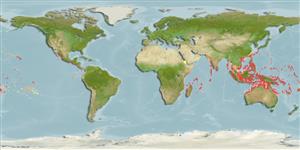Environment: milieu / climate zone / depth range / distribution range
Ecology
Marine; reef-associated; depth range 20 - 40 m (Ref. 1602), usually 20 - ? m (Ref. 1602). Tropical; 30°N - 24°S
Indo-West Pacific.
Size / Weight / Age
Maturity: Lm ? range ? - ? cm
Max length : 16.0 cm TL male/unsexed; (Ref. 4421)
Dorsal
spines
(total): 1 - 2;
Dorsal
soft rays
(total): 30-33;
Anal
spines: 0;
Anal
soft rays: 27 - 30. Blackish brown or bluish black head and anterior portion of body, rest of the body orange. A black blotch surrounding the gill opening. Caudal fin orange; soft dorsal and anal fins yellow; first dorsal spine blackish brown. Pelvic rudiment large not broadly attached to posterior margin of ventral flap. Scale ridge rugosities of male usually develop at about 65 mm SL. Scale spinulation on midbody not closely packed.
Inhabits clear coastal reefs and protected outer reef habitats with rich invertebrate growth (Ref. 48637). Prefers deeper reefs. Often in pairs (Ref. 9710). Sometimes solitary (Ref. 90102). Secretive, adults are usually in pairs (Ref. 48637).
Life cycle and mating behavior
Maturity | Reproduction | Spawning | Eggs | Fecundity | Larvae
Hutchins, J.B., 1986. Review of the monacanthid fish genus Pervagor, with descriptions of two new species. Indo-Pac. Fish. (12):35 p. (Ref. 527)
IUCN Red List Status (Ref. 130435)
Threat to humans
Harmless
Human uses
Fisheries: minor commercial; aquarium: commercial
More information
ReferencesAquacultureAquaculture profileStrainsGeneticsElectrophoresesHeritabilityDiseasesProcessingNutrientsMass conversion
Tools
Special reports
Download XML
Internet sources
Estimates based on models
Preferred temperature (Ref.
123201): 24.9 - 29, mean 27.8 °C (based on 316 cells).
Phylogenetic diversity index (Ref.
82804): PD
50 = 0.5039 [Uniqueness, from 0.5 = low to 2.0 = high].
Bayesian length-weight: a=0.01995 (0.00943 - 0.04220), b=2.93 (2.75 - 3.11), in cm total length, based on LWR estimates for this (Sub)family-body shape (Ref.
93245).
Trophic level (Ref.
69278): 2.9 ±0.4 se; based on size and trophs of closest relatives
Resilience (Ref.
120179): High, minimum population doubling time less than 15 months (Preliminary K or Fecundity.).
Fishing Vulnerability (Ref.
59153): Low vulnerability (10 of 100).
Nutrients (Ref.
124155): Calcium = 68.7 [29.0, 170.0] mg/100g; Iron = 0.778 [0.357, 1.813] mg/100g; Protein = 17.9 [15.7, 20.1] %; Omega3 = 0.109 [0.051, 0.224] g/100g; Selenium = 30.6 [14.7, 70.2] μg/100g; VitaminA = 66.6 [18.2, 244.0] μg/100g; Zinc = 1.51 [0.98, 2.40] mg/100g (wet weight);
